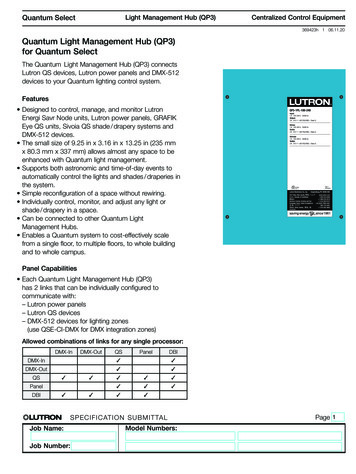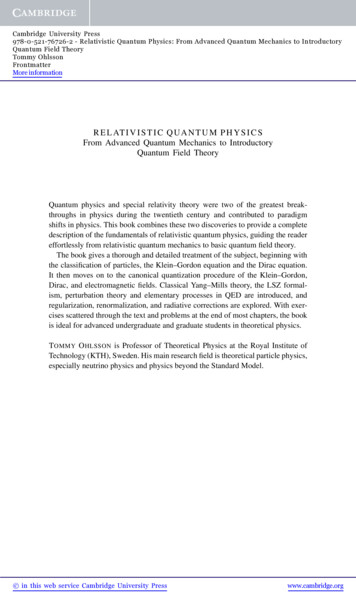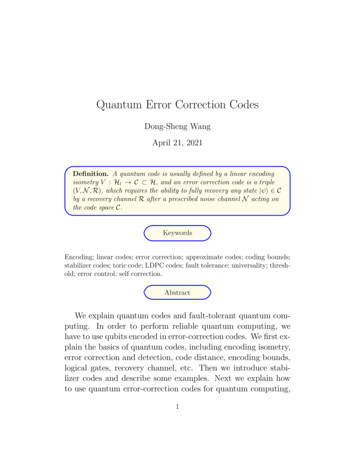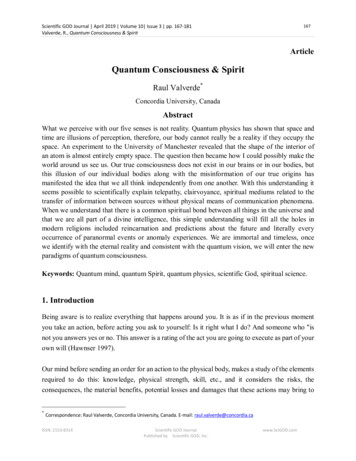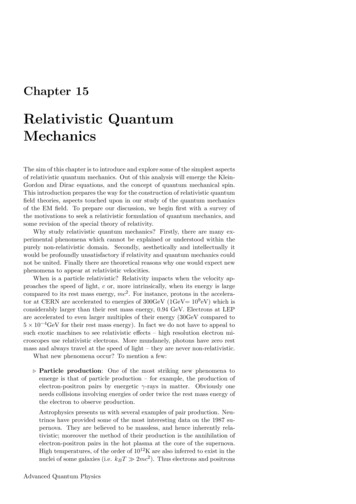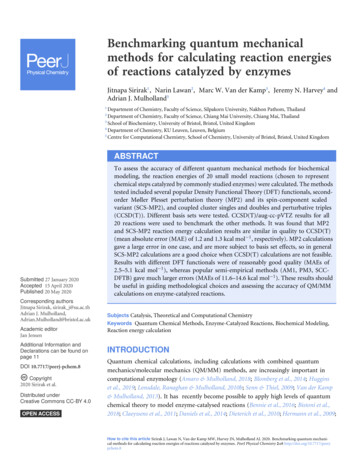
Transcription
Benchmarking quantum mechanicalmethods for calculating reaction energiesof reactions catalyzed by enzymesJitnapa Sirirak1 , Narin Lawan2 , Marc W. Van der Kamp3 , Jeremy N. Harvey4 andAdrian J. Mulholland51Department of Chemistry, Faculty of Science, Silpakorn University, Nakhon Pathom, ThailandDepartment of Chemistry, Faculty of Science, Chiang Mai University, Chiang Mai, Thailand3School of Biochemistry, University of Bristol, Bristol, United Kingdom4Department of Chemistry, KU Leuven, Leuven, Belgium5Centre for Computational Chemistry, School of Chemistry, University of Bristol, Bristol, United Kingdom2ABSTRACTSubmitted 27 January 2020Accepted 15 April 2020Published 20 May 2020Corresponding authorsJitnapa Sirirak, sirirak j@su.ac.thAdrian J. Mulholland,Adrian.Mulholland@bristol.ac.ukTo assess the accuracy of different quantum mechanical methods for biochemicalmodeling, the reaction energies of 20 small model reactions (chosen to representchemical steps catalyzed by commonly studied enzymes) were calculated. The methodstested included several popular Density Functional Theory (DFT) functionals, secondorder Møller Plesset perturbation theory (MP2) and its spin-component scaledvariant (SCS-MP2), and coupled cluster singles and doubles and perturbative triples(CCSD(T)). Different basis sets were tested. CCSD(T)/aug-cc-pVTZ results for all20 reactions were used to benchmark the other methods. It was found that MP2and SCS-MP2 reaction energy calculation results are similar in quality to CCSD(T)(mean absolute error (MAE) of 1.2 and 1.3 kcal mol 1 , respectively). MP2 calculationsgave a large error in one case, and are more subject to basis set effects, so in generalSCS-MP2 calculations are a good choice when CCSD(T) calculations are not feasible.Results with different DFT functionals were of reasonably good quality (MAEs of2.5–5.1 kcal mol 1 ), whereas popular semi-empirical methods (AM1, PM3, SCCDFTB) gave much larger errors (MAEs of 11.6–14.6 kcal mol 1 ). These results shouldbe useful in guiding methodological choices and assessing the accuracy of QM/MMcalculations on enzyme-catalyzed reactions.Subjects Catalysis, Theoretical and Computational ChemistryKeywords Quantum Chemical Methods, Enzyme-Catalyzed Reactions, Biochemical Modeling,Academic editorJan JensenReaction energy calculationAdditional Information andDeclarations can be found onpage 11INTRODUCTIONDOI 10.7717/peerj-pchem.8Copyright2020 Sirirak et al.Distributed underCreative Commons CC-BY 4.0OPEN ACCESSQuantum chemical calculations, including calculations with combined quantummechanics/molecular mechanics (QM/MM) methods, are increasingly important incomputational enzymology (Amaro & Mulholland, 2018; Blomberg et al., 2014; Hugginset al., 2019; Lonsdale, Ranaghan & Mulholland, 2010b; Senn & Thiel, 2009; Van der Kamp& Mulholland, 2013). It has recently become possible to apply high levels of quantumchemical theory to model enzyme-catalysed reactions (Bennie et al., 2016; Bistoni et al.,2018; Claeyssens et al., 2011; Daniels et al., 2014; Dieterich et al., 2010; Hermann et al., 2009;How to cite this article Sirirak J, Lawan N, Van der Kamp MW, Harvey JN, Mulholland AJ. 2020. Benchmarking quantum mechanical methods for calculating reaction energies of reactions catalyzed by enzymes. PeerJ Physical Chemistry 2:e8 http://doi.org/10.7717/peerjpchem.8
Ranaghan et al., 2019; Lawan et al., 2019; Mata et al., 2008; Van der Kamp, Perruccio &Mulholland, 2008; Van der Kamp et al., 2010), e.g., to model systems containing tens ofatoms, i.e., of the size used in cluster models or as the QM region in a typical QM/MMcalculation on an enzyme. Methods such as CCSD(T) offer the potential of ‘chemicalaccuracy’ (i.e., agreement with experiment to within 1 kcal mol 1 ) in quantum chemicalcalculations (Bennie et al., 2016; Bistoni et al., 2018; Claeyssens et al., 2011; Daniels et al.,2014; Dieterich et al., 2010; Hermann et al., 2009; Lawan et al., 2019; Mata et al., 2008;Mulholland, 2007; Ranaghan et al., 2019; Van der Kamp, Perruccio & Mulholland, 2008;Van der Kamp et al., 2010; Zhang & Valeev, 2012). These methods provide a benchmarkagainst which more approximate quantum chemical methods can be tested. This isimportant, because many applications to enzymes are likely (for reasons of computationalrequirements) to apply lower-level QM methods, e.g., for extensive reaction pathway orHessian calculations (Lodola et al., 2005), or for biomolecular simulations (Khandogin,Musier-Forsyth & York, 2003; Khandogin & York, 2004), or for systems such as transitionmetal complexes. Here we compare and test a variety of quantum chemical methods thatare commonly applied to model enzyme reaction mechanisms.There are many levels of QM electronic structure calculations, falling into the broadcategories of ab initio, semiempirical, and density-functional theory methods. Ab initio QMmethods include Hartree-Fock (HF), coupled cluster singles and doubles and perturbativetriples CCSD(T), second-order Møller Plesset perturbation theory (MP2) and its spincomponent scaled variant (SCS-MP2) aim at the solution of the Schrödinger equationand hence focus on the wavefunction of the system. Semiempirical molecular orbital QMmethods (Frisch et al., 2009; Thiel & Voityuk, 1992; Thiel & Voityuk, 1996), such as AM1and PM3, neglect many of the terms that would arise in an ab initio calculation, and most ofthe remaining terms are represented by simpler functions, parameterized against theoreticalor experimental data. These techniques have been modified to allow semiempiricalelectronic structure calculations on whole proteins (Khandogin, Musier-Forsyth & York,2003; Khandogin & York, 2004; Van der Vaart et al., 2000). For density-functional theorymethods (DFT), all properties are derived from the electron density. The computationaleffort required for DFT calculations is typically much smaller than that for correlated abinitio treatments, typically similar to HF theory, with a much higher accuracy than thatof HF (Sousa, Fernandes & Ramos, 2007). There are many density functionals availablefor modeling enzyme reactions including BP86, BLYP, BPW91, B3LYP and B3PW91.Different functionals differ e.g., in their exchange-correlation functionals. A drawback ofmany density functionals is the lack of dispersion interaction (attractive Van der Waalsforces), but empirical corrections can alleviate this problem (Grimme, 2004; Grimme, 2006;Jurečka et al., 2007; Wu & Yang, 2002). The resulting DFT-D3 methods (Grimme et al.,2010) are believed to be a promising method for calculations on biomolecular systems,where dispersion interactions are important (Schwabe & Grimme, 2008; Lonsdale, Harvey& Mulholland, 2012; Zhang & Chen, 2015).Simplified DFT-based approaches which aim to retain DFT-type accuracy at reducedcomputational cost are also available (Foulkes & Haydock, 1989; Goringe, Bowler &Sirirak et al. (2020), PeerJ Physical Chemistry, DOI 10.7717/peerj-pchem.82/20
Hernández, 1997; Porezag et al., 1995; Seifert, Eschrig & Bierger, 1986), such as the selfconsistent charge density functional tight-binding (SCC-DFTB) method (Elstner et al.,1998). This method is a non-iterative DFTB implementation which introduces relaxationof the charge density at the level of Mulliken populations. This makes the method ableto deal with in polar systems, in contrast to non-self-consistent tight binding approaches(Elstner et al., 2003). SCC-DFTB (and variants) is an increasingly widely used method inQM/MM studies of biomolecules (Capoferri et al., 2011; Elstner et al., 2000; Elstner, 2006;Lence et al., 2018; Liu et al., 2001).In planning or judging QM/MM calculations, it is important to choose an appropriatequantum mechanical method. One must balance accuracy against feasibility of calculations,considering factors such as the size of the system, and how many calculations are needed.Several studies have reported the comparison of quantum mechanical methods forcalculating reaction energy (Friedrich & Hänchen, 2013; Margraf, Ranasinghe & Bartlett,2017) and for modelling enzyme-catalyzed reactions (Himo & Siegbahn, 2003; Kromann etal., 2016; Wappett & Goerigk, 2019).Here, we compare a range of quantum mechanical methods and basis sets that areoften used for QM/MM calculations. We apply these methods for calculating 20 reactionenergies of reactions (Fig. 1) related to the following enzymes (amongst others): citratesynthase (Bennie et al., 2016; Mulholland, Lyne & Karplus, 2000; Van der Kamp, Perruccio& Mulholland, 2007a; Van der Kamp, Perruccio & Mulholland, 2007b; Van der Kamp,Perruccio & Mulholland, 2008) (reaction 1–10, 14–17), aromatic amine dehydrogenase(AADH) (Johannissen, Scrutton & Sutcliffe, 2008; Masgrau et al., 2007; Pang et al., 2010;Ranaghan et al., 2017; Roujeinikova et al., 2007; Zelleke & Marx, 2017) (reaction 11),methylamine dehydrogenase (MADH) (Faulder et al., 2001; Nunez et al., 2006; Ranaghanet al., 2007; Tresadern et al., 2003; Zelleke & Marx, 2017) (reaction 12), proton transfer in atypical protein salt-bridge (reaction 13), class A β-lactamases (Chudyk et al., 2014; Hermannet al., 2003; Hermann et al., 2005; Hermann et al., 2006; Hermann et al., 2009; Langan et al.,2018; Meroueh et al., 2005) (reaction 18), fatty acid amide hydrolase (FAAH) (Lodola etal., 2005; Lodola et al., 2008; Lodola et al., 2010; Lodola et al., 2011; Palermo et al., 2014;Tubert-Brohman, Acevedo & Jorgensen, 2006) (reaction 19) and lysozyme (Bowman, Grant& Mulholland, 2008) (reaction 20), where reaction 1–13 and reaction 14–20 are protontransfer reactions and non-proton transfer reactions, respectively. These reactions representwidely different chemistry, and important classes of enzyme reactions: many of theseenzyme reactions are model systems for testing and development of QM/MM methods.These ‘organic type’ reactions are also amenable to correlated ab initio calculations, forwhich transition metal systems are typically out of reach due to computational demands.The small models of these 20 reactions chosen here allow us to compare various quantummechanical methods and basis sets with high level (CCSD(T)) calculations. Our aim is notto compare against experimental thermochemistry data (which is generally not availablefor complex reactions) but rather against high-level calculations, as a direct comparison ofelectronic structure methods.Sirirak et al. (2020), PeerJ Physical Chemistry, DOI 10.7717/peerj-pchem.83/20
Figure 1 (A-T) Reactions (1–20) related to important classes of enzyme reactions.Full-size DOI: 10.7717/peerjpchem.8/fig-1MATERIALS & METHODSThe approach used in this work is comparable to procedures often applied in QM/MMcalculations on enzyme reactions, for which reaction paths may be optimized with DFTmethods, and then corrected with single point ab initio calculations (Claeyssens et al.,2006; Hermann et al., 2009; Lawan et al., 2019; Van der Kamp et al., 2010). The geometriesof molecules from the 20 reactions were optimized in the gas phase at the B3LYP/6311 G(d) level using the Gaussian03 (Frisch et al., 2004) program (see Table S1 andSupplemental Information 1 for coordinates). Energies of these structures were calculatedSirirak et al. (2020), PeerJ Physical Chemistry, DOI 10.7717/peerj-pchem.84/20
using 24 combinations of quantum mechanical methods and basis sets: B3LYP/6-31 G(d),B3LYP-D3/6-31 G(d), B3LYP/6-311 G(d), B3LYP-D3/6-311 G(d), BP86/6-311 G(d),BP86-D3/6-311 G(d), BLYP/6-311 G(d), BLYP-D3/6-311 G(d), TPSS/6-311 G(d),TPSS-D3/6-311 G(d), BH&HLYP/6-311 G(d), HF/6-311 G(d), HF/aug-cc-pVDZ,HF/aug-cc-pVTZ, MP2/6-311 G(d), MP2/aug-cc-pVDZ, MP2/aug-cc-pVTZ, SCSMP2/aug-cc-pVDZ, SCS-MP2/aug-cc-pVTZ, CCSD(T)/aug-cc-pVDZ, CCSD(T)/augcc-pVTZ, SCC-DFTB, AM1 and PM3 (Table S2). For all DFT, AM1, PM3, HF and MP2/6311 G(d) calculations, the Gaussian03 program was used. For all other calculations,the Molpro92 program (Werner et al., 2012) was employed. CCSD(T)/aug-cc-pVTZresults were calculated as follows: CCSD(T)/aug-cc-pVTZ CCSD(T)/aug-cc-pVDZ [SCS-MP2/aug-cc-pVTZ –SCS-MP2/aug-cc-pVDZ]; this is an estimate of the resultsthat would be obtained at the CCSD(T) level with the aug-cc-pVTZ basis set (Pitoňaket al., 2009; Sherrill, Takatani & Hohenstein, 2009; Smith & Gordon, 2011). For DFT-D3energies, DFTD3 code (Grimme et al., 2010) with zero damping variant was employed toobtain the dispersion energy to add to the DFT energies. From the molecular energies, thereaction energies of each reaction were calculated and compared (Table S3). Zero-pointand thermal contributions were not calculated as these cannot be calculated at the highestlevels (e.g., CCSD(T)) and the aim here is to compare methods for calculating potentialenergy differences.RESULTSReactions energies of reaction 1–20 calculated with other methods are compared with thoseof CCSD(T)/aug-cc-pVTZ, which is, in principle, the most accurate of the approachesconsidered (Tables S4–Table S6). The mean absolute errors (MAEs) of reaction energies ofreaction 1–20, MAEs of proton transfer reactions (PT reactions) and MAEs of non-protontransfer reactions (non-PT reactions) calculated by each method compared with thoseof CCSD(T)/aug-cc-pVTZ were calculated and shown in Fig. 2. These MAEs, standarddeviations (SDs), large absolute errors (LAEs) along with their reaction number were alsoshown in Table S7. Moreover, coefficient of determinations (R2 ) between reaction energiescalculated with other methods and reaction energies calculated with CCSD(T)/aug-ccpVTZ were explored and shown in Table S7.The results show that CCSD(T)/aug-cc-pVDZ has the lowest MAE (0.87 kcal mol 1 )followed by MP2/aug-cc-pVTZ, SCS-MP2/aug-cc-pVDZ and SCS-MP2/aug-cc-pVTZwhich have MAEs of 1.16, 1.34 and 1.45 kcal mol 1 , respectively. It should be notedthat, for some reactions (reaction 15–18), the absolute errors of 2.4 to 2.8 kcal mol 1 areobtained from CCSD(T)/aug-cc-pVDZ. This indicates sensitivity to basis set for CCSD(T)calculations. Small basis sets are known to lead to inaccuracies for correlated wave-functionmethods. For CCSD(T) calculations, a large basis set (e.g. aug-cc-pVTZ) is required toachieve convergence (Helgaker, Klopper & Tew, 2008; Nagy & Jensen, 2017). Although theMAE of MP2/aug-cc-pVTZ is not significantly different from the MAE of SCS-MP2/augcc-pVDZ and SCS-MP2/aug-cc-pVTZ, the SD is much larger. This is due to a particularlypoor performance of MP2/aug-cc-pVTZ in calculating the reaction energy of reaction 11Sirirak et al. (2020), PeerJ Physical Chemistry, DOI 10.7717/peerj-pchem.85/20
Figure 2 Comparison of mean absolute errors (MAEs) of reaction energies of reaction 1–20, MAEsof proton transfer reactions (PT reactions) and MAEs of non-proton transfer reactions (non-PT reactions). The mean absolute errors were given relative to the CCSD(T)/aug-cc-pVTZ (in kcal mol 1 ).Full-size DOI: 10.7717/peerjpchem.8/fig-2(absolute error of 6.39 kcal mol 1 whereas its absolute errors from the other reactions was2.22 kcal mol 1 or less). For SCS-MP2/aug-cc-pVTZ, the largest absolute error and SDwere only 2.48 kcal mol 1 (reaction 14) and 0.78 kcal mol 1 , respectively, which are alsolower than those of SCS-MP2/aug-cc-pVDZ (LAE 3.48 kcal mol 1 (reaction 20) and SD 1.01 kcal mol 1 ). These results indicate that SCS-MP2 is preferable to standard MP2for calculations of reaction energies. In addition, the coefficient of determinations (R2 )of SCS-MP2/aug-cc-pVDZ and MP2/aug-cc-pVTZ for 20 reactions (Table S7) (0.999 and0.997, respectively) indicate that, compared to MP2, the SCS-MP2 method with a smallerbasis set gives results close to accurate coupled-cluster calculations, at considerably lesscomputational expense.AM1 was found to have the largest MAE (14.58 kcal mol 1 ) followed by PM3 (12.01 kcalmol 1 ) and SCC-DFTB (11.56 kcal mol 1 ). The largest absolute errors of AM1, PM3 andSCC-DFTB were 30.03 kcal mol 1 (reaction 5), 21.32 kcal mol 1 (reaction 3) and 29.44kcal mol 1 (reaction 3), respectively. This indicates that, in comparison of semi-empiricalmethods, SCC-DFTB is the best method for the calculation of reaction energies, especiallyfor non-PT reactions. It can be noted that MAE of non-PT reactions obtained fromSCC-DFTB (5.98 kcal mol 1 ) is lower than those of B3LYP without dispersion correction(6.32 kcal mol 1 ). The correlation plot between CCSD(T)/aug-cc-pVTZ reaction energiesand SCC-DFTB reaction energies for non-PT reactions obtained has the linear regressionline equation of y 0.77x 3.46 (R2 0.944) (Fig. 3). However, semi-empirical methodsperform particularly badly for PT reactions involving OH as the base (reaction 1–5) forwhich the MAEs of AM1, PM3 and SCC-DFTB are 26.92, 18.24 and 24.72 kcal mol 1 ,respectively. When omitting reactions with OH as the base, the MAEs of AM1, PM3 andSCC-DFTB decrease to 10.60, 5.00 and 7.80 kcal mol 1 , respectively.Sirirak et al. (2020), PeerJ Physical Chemistry, DOI 10.7717/peerj-pchem.86/20
Figure 3 Reaction energies for proton transfer reactions (PT) and non-proton reactions (non-PT)calculated by six quantum chemical methods plotted against with CCSD(T)/aug-cc-pVTZ results. Sixquantum chemical methods include (A) SCS-MP2/aug-cc-pVDZ, (B) MP2/aug-cc-pVTZ, (C) BP86D3/6-311G (d), (D) B3LYP-D3/6-31G (d), (E) HF/aug-cc-pVDZ, and (F) SCC-DFTB. All values are inkcal mol 1 .Full-size DOI: 10.7717/peerjpchem.8/fig-3All DFT functionals without dispersion correction have similar MAEs at 3.56–5.10kcal mol 1 , whereas the equivalent DFT-D3 functionals have somewhat smaller MAEs at2.53–3.69 kcal mol 1 . BP86-D3/6-311 G(d) has the smallest MAE of 2.53 kcal mol 1 . Foreach DFT method, the MAE is slightly larger than that of the equivalent DFT-D3 method.This indicates that in inclusion of dispersion corrections improves the results. The largestabsolute error obtained from DFT and DFT-D3 methods were 12.45 kcal mol 1 (reaction19 with BLYP/6-311 G(d)) and 9.28 kcal mol 1 (reaction 19 with BLYP-D3/6-311 G(d)),respectively. Absolute errors for reaction 13 obtained from all DFT functionals are ratherSirirak et al. (2020), PeerJ Physical Chemistry, DOI 10.7717/peerj-pchem.87/20
large (minimum of 6.72 kcal mol 1 and 7.81 kcal mol 1 in average). This indicates that allDFT functionals perform particularly badly for reaction 13, which involves a large changein conjugation. This error may be due to self-interaction error in DFT (Bao, Gagliardi &Truhlar, 2018; Gräfenstein & Cremer, 2009; Schmidt et al., 2014).For HF, the MAEs (5.94–7.83 kcal mol 1 ) are higher than those of DFT but much lowerthan those of AM1, PM3 and SCB-DFTB. Interestingly, MAEs of HF with Dunning basisset for PT are only 1.72–1.91 kcal mol 1 , which are lower than those of DFT functionals(2.20–3.44 kcal mol 1 ). This indicates that HF performs particularly well for calculatingreaction energies of PT.MP2 and HF are clearly sensitive to basis set (MP2 with aug-cc-pVTZ and aug-cc-pVDZ,MAEs are 1.16 and 1.75 kcal mol 1 , whereas with 6-311 G(d) the MAE is 3.92 kcal mol 1 ).The DFT results are less sensitive to the basis set. Increasing basis set size does not alwaysimprove the accuracy of the DFT functionals. For example, the MAE of B3LYP/6-311 G(d)is 0.11 kcal mol 1 larger than that of B3LYP/6-31 G(d).DISCUSSIONAM1 and PM3 are found (as expected) to perform poorly in calculating reaction energycompared to all the other methods (MAEs of 14.58 and 12.01 kcal mol 1 , respectively).This is due to the fact that AM1 and PM3 include many approximations. Errors in reactionbarriers from these methods are likely to be larger than the errors in reaction energiesreported here. With a speed comparable to the semiempirical AM1 and PM3 methodsand 2–3 orders of magnitude faster than ab initio and DFT methods, SCC-DFTB is foundto perform similarly to PM3 and better than AM1 for the 20 reaction energies computedhere (MAE of 11.56 kcal mol 1 ). Additionally, our results demonstrate that SCC-DFTBperforms very well for the calculation of reaction energies of non-PT reactions. Otte etal. found that the overall accuracy of SCC-DFTB was similar to popular semiempiricalmethods and its performance for geometries was very good, but the method appeared tobe less suitable for radicals and excited states (Otte, Scholten & Thiel, 2007). Sattelmeyer,Tirado-Rives & Jorgensen (2006) compared the performance of SCC-DFTB and NDDObased semiempirical methods and found that SCC-DFTB was typically intermediatebetween AM1 and PM3 for calculating isomerization energies and heats of formation,but less accurate for heats of formation of ions and radicals. Good performance of DFTBfor the calculation of zero-point corrected reaction energies compared to BLYP and G2methods was also observed by Krüger and Elstner (Kruger et al., 2005). SCC-DFTB isincreasingly used successfully for QM/MM calculations (Capoferri et al., 2011; Elstner,2006; Hou et al., 2012). Elstner et al. have also developed DFTB3 which are particularlyuseful for biomolecular systems because it improves the description of charged systemscontaining elements C, H, N, O, and P, especially regarding hydrogen binding energies andproton affinities (Gaus, Cui & Elstner, 2011).For the biologically relevant reaction energies considered here, HF with a 6-311 G(d)basis set performs much better than the semi-empirical methods (a MAE less than half).However, HF results show relatively large errors compared with the other methodsSirirak et al. (2020), PeerJ Physical Chemistry, DOI 10.7717/peerj-pchem.88/20
(MAE of 5.94–7.83 kcal mol 1 ). HF also typically overestimates the activation energies andenthalpies, e.g., for a Claisen rearrangement in chorismate mutase (CM) and an electrophilicaromatic substitution in para-hydroxybenzoate hydroxylase (PHPH) by about factor of3, compared with LCCSD(T0) (Claeyssens et al., 2006). However, the errors of HF tendto be systematic and may partly cancel out when comparing similar systems. Moreover,HF does well for predicting proton transfer reaction energies, because the proton carriesno electrons with it and this type of reaction is therefore considerably less sensitive to thedifferential electron correlation in the reactants and the products (Cramer, 2004). QM/MMcalculations on proton transfer in citrate synthase showed that this depends on the basis setused, however: QM/MM reaction energies with HF/6-31 G(d) and HF/aug-cc-pVDZ were11.8 and 3.2 kcal mol 1 higher than with LCCSD(T0)/aug-cc-pVDZ, respectively (Vander Kamp et al., 2010). Good HF results for reaction energies are obtained for some reactiontypes, such as isomerization reactions (Hehre, 1995; St.-Amant et al., 1995). Further, HFcoupled with a dispersion correction has been found to be suitable for the optimization ofsmall gas-phase peptide structures (Goerigk, Collyer & Reimers, 2014).DFT methods are far superior to the AM1, PM3, SCC-DFTB and HF methods. TheDFT MAEs are typically less than half of that of HF. Moreover, the results of differentDFT functionals are similar. Although errors of DFT are about 50% larger than thoseof correlated ab initio calculations, their errors are still relatively small (2.53–5.10 kcalmol 1 ). DFT is consequently a valuable tool for systems which do not need very highaccuracy. Notably, the results reported in this work indicate that the accuracy of DFTcan be improved by an empirical correction for dispersion (Grimme et al., 2010; Jurečkaet al., 2007; Lonsdale, Harvey & Mulholland, 2010a; Lonsdale, Harvey & Mulholland, 2012),which requires very little additional computational effort. Although the (meta)-GGAfunctionals (BP86 and TPSS) do remarkably well once the dispersion correction is added,they are likely to perform much worse for transition states (and therefore reaction barriers),due to their semi-local nature. Additionally, because the computational effort required forDFT calculations is typically comparable with that required for HF, DFT and DFT-D3 arehighly attractive, especially for medium to large systems for which the costs of correlated abinitio calculations are prohibitive (Himo & Siegbahn, 2003; Kromann et al., 2016; Lonsdale,Harvey & Mulholland, 2012; Zheng, Zhao & Truhlar, 2009). A good performance of DFT-Dfor geometries compared to DFT was also observed by Wappett and Goerigk (Wappett &Goerigk, 2019).Prior to the advent of DFT, second-order Møller-Plesset perturbation theory (MP2)(Pople, Binkley & Seeger, 1976) was the simplest and the least expensive way of incorporatingelectron correlation effects in ab initio electronic structure calculations. MP2 is sometimesconsidered to be less accurate compared to density functionals such as B3LYP (Baker etal., 1996), though this lower accuracy is mainly encountered when using a basis set thatis too small. It should however be noted that it is well known that convergence problemsin the Møller-Plesset series appear primarily with extended basis sets (Olsen et al., 1996).The results presented here also demonstrate, as expected, that MP2 is very sensitive to thetype of basis set used. In addition, for properties involving making or breaking of electronpairs, the performance of MP2 methods is substantially inferior to that of CCSD(T) andSirirak et al. (2020), PeerJ Physical Chemistry, DOI 10.7717/peerj-pchem.89/20
also not as good as the best DFT methods (Friesner, 2005). Hobza also demonstratedthat MP2 overestimates dispersion interactions for non-covalent interactions (Hobza &Müller-Dethlefs, 2009). MP2 often gives surprisingly good results, especially if large basissets are used (Helgaker et al., 1997; Jurecka et al., 2006).For the calculation of reaction energies presented here, the simple modification ofthe MP2 approach termed SCS-MP2 (spin-component-scaled MP2) (Grimme, 2003) isfound to be the best method compared to high-level coupled cluster theory. SCS-MP2provides quite substantial corrections to the ground state energies, especially for moleculeswith complicated electronic structure, giving better performance than conventional MP2.Moreover, SCS-MP2 can give good predictions for energy barriers, hence SCS-MP2is a good, reasonably affordable method for organic-type enzyme reactions (Bennie etal., 2016; Lawan et al., 2014; Lawan et al., 2019; Van der Kamp et al., 2010). Therefore,our benchmarking results here may help guide choices of QM methods for QM/MMcalculations.Overall the comparisons in this work show that MP2 and SCS-MP2 are in best agreementwith CCSD(T)/aug-cc-pVTZ. Much larger errors are observed for AM1, PM3 and SCCDFTB. Acceptable reaction energies are obtained from DFT and DFT-D3. DFT methodshave also been found to give reasonable energy barriers for QM/MM calculations ofpotential energy barriers for enzyme-catalyzed reactions, compared with barriers derivedfrom experiments and/or calculated with correlated ab initio methods (Kaiyawet et al.,2015; Lawan et al., 2019; Mlýnský et al., 2014; Rydberg et al., 2014; Van der Kamp, Perruccio& Mulholland, 2008).Clearly, for modeling enzyme-catalyzed reaction, the accuracy of the results (such asthe activation barrier, reaction energy and reaction pathway) depend not only on the QMmethod and basis set but also on other effects including the representation of surroundingamino acid residues and water environment, the size of QM regions etc (Boereboom,Fleurat-Lessard & Bulo, 2018; Jász et al., 2020 Mulholland, 2007; Ranaghan et al., 2019;Wappett & Goerigk, 2019). Hence, it would be of interest to (1) use larger model systemscontaining longer fragments or the nearest amino acid residues to test effects of system size,and (2) test more functionals and newer semiempirical methods. High level calculationssuch as CCSD(T)/aug-cc-pVQZ, which can be applied in QM/MM calculations on enzymes(Bennie et al., 2016; Bistoni et al., 2018; Claeyssens et al., 2011; Daniels et al., 2014; Dieterichet al., 2010; Hermann et al., 2009; Lawan et al., 2019; Mata et al., 2008; Ranaghan et al.,2019; Van der Kamp, Perruccio & Mulholland, 2008; Van der Kamp et al., 2010), can also beused to benchmark other methods.CONCLUSIONSThe accuracy of several quantum mechanical methods for calculating reaction energieshas been assessed for 20 small model reactions representing chemical steps catalyzed byenzymes. CCSD(T)/aug-cc-pVTZ results on a subset indicate that spin-component scaledMP2 (SCS-MP2) has similar accuracy. Comparison of methods for all reactions againstCCSD(T)/aug-cc-pVTZ shows that several DFT functionals are also of good quality,Sirirak et al. (2020), PeerJ Physical Chemistry, DOI 10.7717/peerj-pchem.810/20
especially with dispersion correction. Semi-empirical methods give much larger errors.The results should help with choosing and assessing QM methods for QM/MM calculationson enzyme-catalyzed reactions.ACKNOWLEDGEMENTSWe thank Prof. Fred Manby (University of Bristol) for helpful discussions.ADDITIONAL INFORMATION AND DECLARATIONSFundingThis work was supported by EPSRC (grant numbers EP/M022609/1 and EP/M013219/1),BBSRC (BB/M026280/1, BB/R001332/1), Chiang Mai University, and the Royal ThaiGovernment Scholarship. The funders had no role in study design, data collection andanalysis, decision to publish, or preparation of the manuscript.Grant DisclosuresThe following grant information was disclosed by the authors:EPSRC: EP/M022609/1, EP/M013219/1, BB/M026280/1, BB/R001332.Chiang Mai University.The Royal Thai Government Scholarship.Competing InterestsThe authors declare there are no competing interests.Author Contributions Jitnapa Sirirak and Marc W. Van der Kamp performed the experiments, analyzed thedata, performed the computation work, prepared figures and/or tables, authored orreviewed drafts of the paper, and approved the final draft. Narin Lawan, Jeremy N. Harvey and Adrian J. Mulholland performed the computationwork, authored or reviewed drafts of the paper, and approved the final draft.Data AvailabilityThe following information was supplied regarding data ava
triples CCSD(T), second-order Młller Plesset perturbation theory (MP2) and its spin-component scaled variant (SCS-MP2) aim at the solution of the Schrödinger equation and hence focus on the wavefunction of the system. Semiempirical molecular orbital QM methods (Frisch et al., 2009; Thiel & Voityuk, 1992; Thiel & Voityuk, 1996), such as AM1



